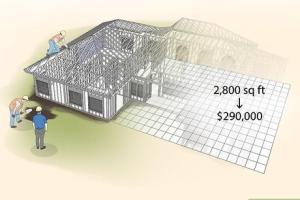Ultimate Guide to Building Your Own Home in the US: Step-by-Step Insights

-
Quick Links:
- 1. Understanding the Basics of Home Building
- 2. Planning Your Home Build
- 3. Choosing the Right Location
- 4. Financing Your Home Build
- 5. Designing Your Home
- 6. Securing Permits and Approvals
- 7. Choosing Materials and Contractors
- 8. Construction Process
- 9. Post-Construction: Moving In
- 10. FAQs
1. Understanding the Basics of Home Building
Building your own home is an empowering journey that allows you to create a space tailored to your preferences and needs. This guide aims to provide a comprehensive understanding of the home building process, from planning to completion.
Home building involves several key phases: planning, financing, designing, obtaining permits, construction, and post-construction activities. Each phase is critical in ensuring a smooth and efficient building process.
2. Planning Your Home Build
The planning phase is crucial. It sets the foundation for your project. Start by defining your goals, budget, and timeline. Consider the following:
- Goals: What do you want from your new home? Think about size, style, and functionality.
- Budget: Determine how much you can afford, including land costs, construction, and finishing.
- Timeline: Establish a realistic timeline for each phase of construction.
3. Choosing the Right Location
Location is one of the most significant factors in the home building process. Consider the following when selecting a site:
- Proximity to Work and Schools: Ensure that your chosen location is convenient for commuting and education.
- Neighborhood: Research the area to ensure it aligns with your lifestyle preferences.
- Land Characteristics: Analyze the land's topography, soil quality, and access to utilities.
4. Financing Your Home Build
Financing is essential for any home building project. Explore the following options:
- Construction Loans: Short-term loans that cover the building period.
- Mortgage Financing: Traditional mortgages can be used once your home is built.
- Personal Savings: Consider using personal funds to minimize debt.
5. Designing Your Home
Design is where your vision comes to life. Work with an architect or use design software to create blueprints. Take into account:
- Functionality: Ensure the layout meets your lifestyle needs.
- Aesthetics: Choose a style that resonates with you, whether modern, traditional, or eclectic.
- Sustainability: Consider energy-efficient designs and materials.
6. Securing Permits and Approvals
Before construction begins, you must obtain the necessary permits. The requirements vary by state and locality. Common permits include:
- Building Permit: Required for any new construction.
- Zoning Permit: Ensures your project complies with local zoning laws.
- Environmental Permits: May be required if your land has environmental restrictions.
7. Choosing Materials and Contractors
Selecting the right materials and contractors is critical for the success of your build. Here are key points to consider:
- Materials: Opt for durable, energy-efficient materials that align with your budget.
- Contractors: Research and hire licensed contractors. Get references and read reviews.
8. Construction Process
The construction phase is where your dreams begin to materialize. Key stages include:
- Site Preparation: Clearing and grading the land.
- Foundation: Laying the foundation is critical for structural integrity.
- Framing: Building the frame of your home.
- Utilities: Installing plumbing, electrical, and HVAC systems.
- Finishing: Completing interior and exterior finishes.
9. Post-Construction: Moving In
Once construction is complete, it's time to move in. However, ensure you conduct a final walkthrough to check for issues. Also, consider the following:
- Home Inspection: Hire a professional to inspect the home before moving in.
- Landscaping: Plan your outdoor space for functionality and aesthetics.
10. FAQs
1. How long does it take to build a home?
Typically, it takes 6 to 12 months, depending on various factors like design complexity and weather conditions.
2. What is the average cost to build a home in the US?
The average cost ranges from $100 to $200 per square foot, depending on the location and materials used.
3. Do I need a contractor to build my own home?
While you can build your own home, hiring a licensed contractor can help navigate permits and construction complexities.
4. Can I finance my home build with a regular mortgage?
Yes, but you may need a construction loan during the building phase, which converts to a mortgage once completed.
5. What permits do I need to build a house?
You typically need a building permit, zoning permit, and possibly environmental permits, depending on your location.
6. How do I choose the right location for my home?
Consider factors like proximity to schools, work, amenities, and the overall neighborhood vibe.
7. Is it possible to build a home on a budget?
Yes, careful planning, choosing affordable materials, and managing labor costs can help keep your budget in check.
8. What are the most important design elements to consider?
Functionality, aesthetics, sustainability, and energy efficiency are key design aspects to focus on.
9. How can I ensure quality during construction?
Regularly inspect the build, hire qualified contractors, and consider a professional home inspection before moving in.
10. What are common mistakes to avoid when building a home?
Common mistakes include inadequate planning, underestimating costs, and neglecting to secure necessary permits.
Random Reads
- Create html signature gmail
- Create infinite water supply minecraft
- How to image hard drive windows mac
- How to import bookmarks to microsoft edge
- How to protect your email account from hackers
- How to fullscreen a game
- How to age brass antique look
- How to advertise a garage sale on craigslist
- How to disable voicemail on android
- How to beat minecraft